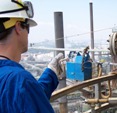
EPA Proposes Significant Changes for Lead Emissions, Monitoring
EPA proposed a significant reduction in the National Ambient Air Quality Standard (NAAQS) for lead emissions on May 1. The agency proposes to move the standard from the 1.5 micrograms per cubic meter of air it has been since 1978 to a range of 0.10 to 0.30 micrograms per cubic meter.
EPA also proposes to revise various elements of the standard to provide increased protection for children and other at-risk populations against an array of adverse health effects, most notably, effects on the developing nervous system.
The U.S. District Court in St. Louis ordered the lead NAAQS review and set the schedule in response to a lawsuit by the Missouri Coalition for the Environment in September 2005. Consistent with the terms of a court order, the EPA Administrator will sign a notice of final rulemaking by September 15, 2008 for publication in the Federal Register.
EPA's Region 7, home to one of only two non-attainment areas in the U.S. for the lead emissions standard in Herculaneum, Mo., will host one of two public meetings to discuss the lead standard June 12 in St. Louis, Mo. A separate announcement will be made with specifics regarding the meeting at a later date.
EPA has asked for comments regarding the tightening of the NAAQS standard, adjusting the monitoring, and an implementation strategy. Comments are also sought on expanding the monitoring network to both source-based sites and large metropolitan areas. Source-based sites include smelters, iron and steel foundries, and general aviation gasoline. The metropolitan area monitoring would be required for metropolitan areas that exceed 1,000,000 in population.
Exposure to lead pollution is associated with a broad range of health effects including damage to the central nervous system, cardiovascular system, kidneys, and red blood cells. Lead emitted into the air can be inhaled directly or ingested after it settles onto surfaces or soils. Children are the most vulnerable to damaging effects of lead because their body systems are developing rapidly.